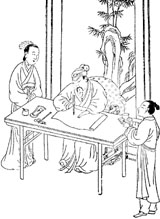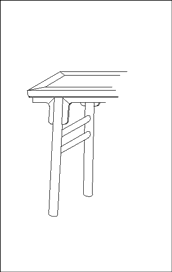 The practical and minimalistic 'recessed-leg' form was established by the Song dynasty and continued to be reproduced throughout the Ming and Qing dynasties. This basic construction pattern, which was closely related to traditional post-and-beam architecture, was commonly applied to the creation of stools, chairs, tables and cabinets.
The practical and minimalistic 'recessed-leg' form was established by the Song dynasty and continued to be reproduced throughout the Ming and Qing dynasties. This basic construction pattern, which was closely related to traditional post-and-beam architecture, was commonly applied to the creation of stools, chairs, tables and cabinets.
|

 The 'recessed-leg' technique employs legs joined at points inset (or 'recessed') from the corners of a mitered frame. The legs generally splay outward toward the base, and are connected by various configurations of stretchers and/or aprons. The aprons in this example are joined to the single-piece spandrel heads with a blind dovetail. Double tenons on the top of each leg fit into the underside of the frame.
The 'recessed-leg' technique employs legs joined at points inset (or 'recessed') from the corners of a mitered frame. The legs generally splay outward toward the base, and are connected by various configurations of stretchers and/or aprons. The aprons in this example are joined to the single-piece spandrel heads with a blind dovetail. Double tenons on the top of each leg fit into the underside of the frame.